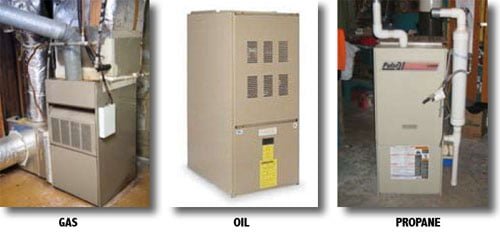
Furnaces can be fueled by natural gas, oil or propane.

All furnace motors use electricity, but some are more efficient than others. The furnace motor could be either DC (direct current) or ECM (electronically commutated motor). An ECM motor is considered to be more efficient, and is preferable to an AC, or alternating current, motor.

Furnace efficiency is measured as low, mid or high efficiency; older furnaces that are considered to be low efficiency may only be 55% - 68% effective, while high efficiency are 90% - 96% efficient or more. Mid-efficiency furnaces are between 78-82% efficient. A simple way to to determine their efficiency is how they are vented: low-efficiency will be vented up through a chimney, mid-efficiency furnaces are vented up a chimney with a metal liner, and high-efficiency will be vented directly out an exterior wall.

An inspection of the ductwork will indicate if there are any holes or seams that require sealing. Ideally, there will not be any gaps in the ductwork.
Each air conditioning unit has a SEER, or seasonal energy efficiency ratio, that is associated with it. The SEER indicates the energy-efficiency of the unit, as it measures the output of cold air in relation to energy consumption. The calculation for a SEER ratio is:
SEER = Btu / Watts per hour
The standard SEER today is 13 in Ontario, but a homeowner should consider purchasing a higher SEER rated unit to decrease monthly home operating costs, and significantly reduce the lifecycle cost over the life of the unit (approximately 15 years). To find the SEER associated with the unit, check the owner’s manual.
 HRV, or heat recovery ventilation systems, allow homes to maintain high air quality without excessive incurring additional energy costs. It consists of two separate air-handling systems; one that collects and exhausts stale indoor air, and the other that draws outdoor air in and distributes it through the home.
HRV, or heat recovery ventilation systems, allow homes to maintain high air quality without excessive incurring additional energy costs. It consists of two separate air-handling systems; one that collects and exhausts stale indoor air, and the other that draws outdoor air in and distributes it through the home.
An electronic air cleaner will remove very small particles from the air that affect air quality.